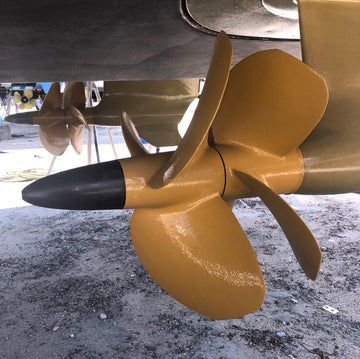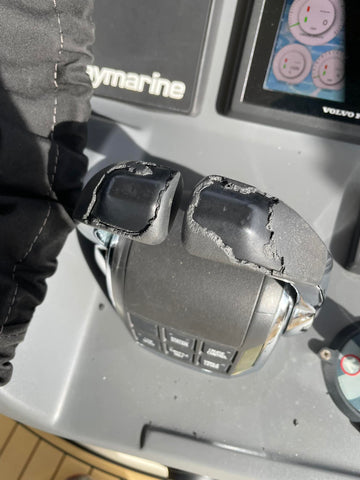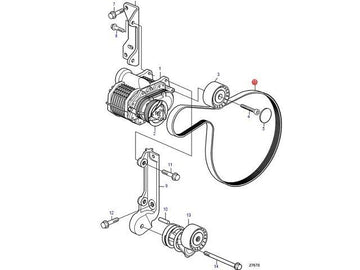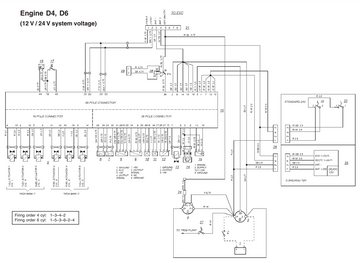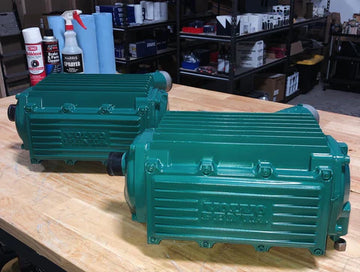One of the most common questions we get regarding the D6 engine is how we feel about Volvo's Integrated Propulsion System (IPS). The answer is pretty simple. If you have the money to play the game, there's nothing else like it as far as performance goes. If you don't have the money, and you try to skimp on maintenance, an IPS Pod boat will eat a hole in your wallet, especially in salt water.

IPS is unlike any other propulsion system in the world. The thrust angle and forward facing counter-rotating propellers provide extremely efficient use of engine torque and power. This allows us to propel a vessel at the same speed as a straight-shaft application but with a smaller engine and a smaller engine means less fuel burn. The ability for the pods to turn Port and Starboard, coupled with Volvo's joystick technology, gives us incredible handling capabilities allowing "Amateurs to look like professionals, and Professionals to look like God." when it comes to docking and maneuvering the vessel in tight passages. In addition, pod technology allows for a quick replacement of the entire pod unit, minimizing down-time when repairs are needed. This was the whole reason pod-propulsion systems became popular on Large commercial vessels. In the commercial vessel world, nothing is more expensive than down-time.
So with all those perks, what are the negatives? Cost of Maintenance for one. IPS oil currently sits at $106/gal as of the time of this blog post. The smallest of the 4 pod sizes taking approx 3.5 gallons, it's almost $1000 just in parts and taxes to service the pods correctly and on most models it's best done out of the water, so factor in the cost of an annual haul-out. While some of the larger and newer model pods allow for pumping out of the oil, it's still the recommendation of Volvo Penta the oil be drained out the bottom as often as possible compared to pumping it out. IPS propeller shafts are ferrous, so exhaust anodes need to be replaced annually and props should be pulled so shafts can be re-greased. If you happen to "bump bottom" you'll need to get a Haulout so your shafts can be measured for straightness or risk water-intrusion if the shaft seals fail.

In our opinion one of the biggest flaws of the IPS system is the lower shares a common oil source with the transmission. On an outboard motor when a shaft seal fails, water simply enters the lower and it's a relatively inexpensive and easy repair. On an IPS Pod when a seal failure in the lower allows water ingress that water is pumped through the transmission. The clutches, bearings, etc are all exposed to this water. The best path forward at this point is removal of the pod and installation of a Volvo Factory Reman unit.
Finding experienced pod mechanics can be a difficult task. It's still a relatively new technology and we find that competent technicians are few and far between when it comes to IPS work. If your vessel stays local and you have a trusted technician nearby who can support you that isn't necessarily a problem, but if you're looking to travel, like say do the Great Loop, you may run into delays and issues if you have pod problems in certain areas.
Years ago I encountered an issue with Charleston Harbor Pilots' Triple IPS Pod Boat, the Fort Ripley. During a run into the harbor at dusk they hit something submerged in the channel which we now believe was a partially sunken shipping container. It was significant enough of an impact that two of the three IPS pods actually sheared off at their engineered failure point. The vessel made it home safe and traveled to the yard the next morning for Haul-out while they had no idea 2 of the 3 pod lowers were gone. Had this impact happened to one of their straight-shaft boats, it would have likely ripped the shafts out of the boat and it would be a miracle for the vessel to make it back home without sinking. Even then it would have been on the hill for weeks while they rebuilt struts, rudders, shafts, etc. Because of the nature of Pod Propulsion, we dropped those two pods, installed two brand new pods, and the vessel was back in the water 48 hours later conducting work. The ability for a commercial work boat to be in an accident that severe and be back at work 48 hours later saved the Pilots a ton of lost revenue. Again, if you have the money to play the game, there's nothing like it.
Out with the old...

In with the new...

Are there Pod horror stories out there? Absolutely. Jump on any online boating forum and you'll find someone with a horror story about an IPS boat. Usually when we ask a few questions and dig in we find they bought a poorly maintained vessel, they didn't have a good mechanical survey performed, and they didn't do their research to realize the cost of upkeep on a pod boat compared to a traditional straight-shaft vessel.
We often use the analogy an IPS boat is like a Porsche and a straight-shaft boat is like a Chevy. Not any mechanic can work on the Porsche, and it's going to be more expensive to maintain and repair than a Chevy, but the Porsche will do things performance and handling wise that a Chevy could only dream of.
If you're looking to purchase an IPS vessel or review the preventative maintenance program on your current IPS vessel give us a shout today!

